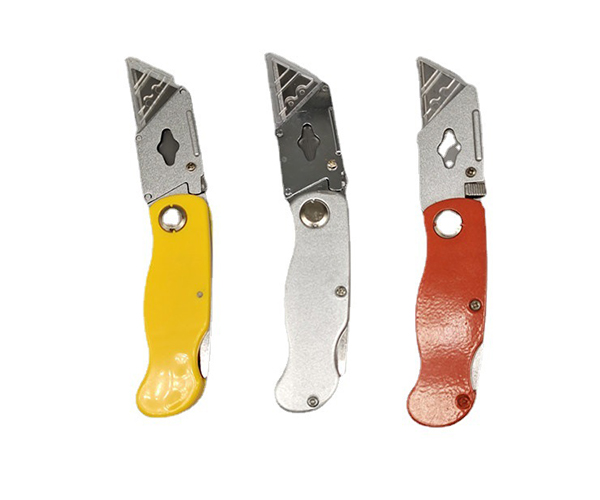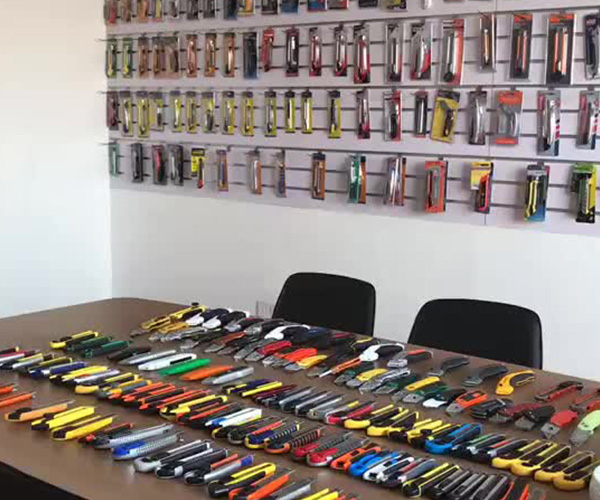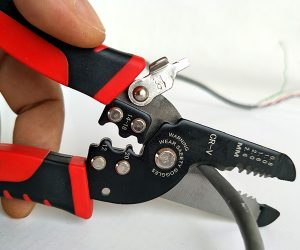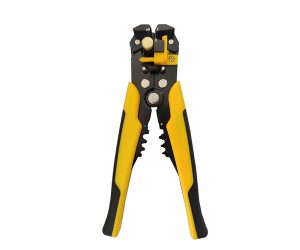When it comes to cutting tools, box cutters and utility knives are often used interchangeably. However, they each have distinct features and advantages, making one more suitable than the other for specific tasks. In this article, we will break down the differences between box cutters and utility knives, exploring their uses, advantages, and limitations to help you make an informed decision on which tool is right for you.
1. What is a Box Cutter?
A box cutter is a small, portable tool commonly used for cutting boxes, cardboard, and other lightweight materials. It typically features a retractable or fixed blade that can be replaced when it becomes dull. Box cutters are designed for precision and ease of use, with many models offering ergonomic grips for comfort during extended use.
But here’s the kicker—while box cutters are great for everyday tasks like opening packages or cutting paper, they aren’t always the most versatile. Many people mistakenly think box cutters can handle heavy-duty tasks, but they can become ineffective when dealing with tougher materials. That’s where the utility knife comes in, which leads us to our next point.
Box cutters are ideal for lighter jobs, especially when precision is key. For example, in a warehouse setting, workers use box cutters daily to open cardboard boxes without damaging the contents. The retractable blade feature ensures safety, making box cutters safer than many other cutting tools.
Table 1: Comparison of Box Cutter Features
| Feature | Box Cutter | Utility Knife |
|---|---|---|
| Blade Type | Retractable or fixed | Retractable or fixed |
| Safety Features | Blade retraction, ergonomic grip | Blade retraction, ergonomic grip |
| Ideal Usage | Cardboard, paper, light cutting | Heavy-duty cutting, thick materials |
| Cost | Generally low-cost | Can be higher depending on the model |
2. What Makes a Box Cutter Different from a Utility Knife?
When comparing a box cutter and a utility knife, the differences may seem subtle, but they play a significant role in determining which tool is right for the job. Utility knives are typically more robust, featuring thicker, longer blades that can handle tougher materials. On the other hand, box cutters are smaller, lighter, and more maneuverable, making them perfect for precise, light-duty tasks.
What’s the real story? Utility knives are designed for more heavy-duty applications, such as cutting through thicker materials like plastic, drywall, and even wood in some cases. They are more durable and can be used in a wider range of environments, from construction sites to workshops. Box cutters, while effective for light tasks, are better suited for situations where precision and ease of use are essential.
Utility knives usually offer a wider variety of blade types, including hook blades, which are great for cutting rope or tape. These knives are often found in commercial and industrial settings, where versatility and durability are crucial.
Table 2: Box Cutter vs Utility Knife – Key Differences
| Feature | Box Cutter | Utility Knife |
|---|---|---|
| Blade Length | Shorter blades, compact design | Longer, sturdier blades |
| Material Durability | Ideal for lightweight materials | Suitable for heavy-duty materials |
| Precision | Highly precise for small tasks | Less precise, but more versatile |
| Blade Variety | Limited blade types | Wide range of blade types |

3. How Does a Box Cutter Work?
A box cutter works by using a sharp blade that can be extended or retracted as needed. The blade is typically made of high-carbon steel or stainless steel, ensuring it remains sharp for extended periods. The design of the box cutter allows for easy blade replacement when necessary, ensuring continuous use without compromising performance.
Ready for the good part? Box cutters typically have a mechanism that locks the blade in place to prevent accidental extension or retraction during use. Many models also have an ergonomic grip to reduce hand strain during extended cutting tasks, which is essential for users working in environments where they frequently need to cut materials.
Box cutters are incredibly simple to use, making them accessible to both beginners and professionals. To use one, all you need to do is extend the blade, and you’re ready to start cutting. The retractable blade adds a layer of safety, allowing you to store the cutter safely when it’s not in use.
Table 3: Common Blade Types for Box Cutters
| Blade Type | Description | Ideal Use |
|---|---|---|
| Snap-Off Blades | Blades with segments that break off as they dull | Lightweight cutting tasks |
| Straight Edge Blades | Standard flat blade | General-purpose cutting |
| Hook Blades | Blades with a hooked edge | Cutting tape, rope, or string |
4. Why Choose a Box Cutter Over Other Cutting Tools?
Box cutters are favored for their convenience, safety features, and precision. They are designed for quick and easy use, making them ideal for smaller, lighter tasks that require accuracy. Whether you are opening a box or trimming a piece of paper, box cutters are easy to handle and effective at making clean cuts.
This is where it gets interesting—while box cutters are excellent for light-duty tasks, they don’t fare well when compared to utility knives in tougher applications. However, when you don’t need to cut through thick materials, a box cutter is the perfect tool for the job.
For example, in retail environments, box cutters are commonly used by store employees to open boxes without damaging the products inside. Their compact size and ease of use make them a great option for such tasks, offering a level of safety that heavier tools simply cannot match.
Table 4: Box Cutter vs Other Tools
| Tool | Ideal Usage | Limitations |
|---|---|---|
| Box Cutter | Light-duty tasks like cutting cardboard and paper | Not suitable for thick materials |
| Scissors | Cutting paper, fabric, and thin materials | Limited to softer materials |
| Utility Knife | Cutting through tough materials like plastic and wood | Can be bulkier and harder to control |
5. How to Use a Box Cutter Safely?
When using a box cutter, safety is paramount. One of the first things to remember is to always keep the blade retracted when it is not in use. This simple step reduces the risk of accidents and ensures the tool is stored safely.
What’s the deal here? For added safety, always ensure you’re using the correct cutting technique. The best way to cut with a box cutter is to apply a consistent, gentle pressure as you slice through the material. Never force the blade, as this can result in the blade snapping or causing an accident.
Additionally, wearing protective gloves can help prevent injuries, especially when working with tougher materials. Keep your fingers away from the cutting path, and always store the cutter in a safe location when not in use.
Table 5: Box Cutter Safety Tips
| Safety Tip | Explanation |
|---|---|
| Retract the Blade | Always retract the blade when not in use |
| Wear Protective Gloves | Helps prevent accidental cuts |
| Keep Fingers Away | Avoid placing your hand near the cutting path |
6. What Are the Different Types of Box Cutters?
Box cutters come in a variety of styles, from basic, manual models to more advanced versions with features designed for heavy-duty use. The two most common types are fixed blade box cutters and retractable blade box cutters.
This is where it gets good—retractable box cutters offer the added benefit of being safer to store and carry. Fixed blade cutters, on the other hand, are often used in industrial settings where constant use demands a more durable tool.
Each type of box cutter has its strengths, and the best one for you depends on the type of work you do. For general use around the house or office, a retractable box cutter is often the best choice. However, if you work in a more demanding environment, a fixed blade box cutter may be better suited for your needs.
7. What Are the Best Brands of Box Cutters?
When choosing a box cutter, the brand can make a significant difference in terms of quality, durability, and safety features. There are several reputable brands in the market that offer reliable box cutters suited for various tasks. Some of the most popular brands include Stanley, Fiskars, and OLFA.
Ready for the good part? Each of these brands offers different features that cater to specific user needs. Stanley, for instance, is well-known for its heavy-duty box cutters that can withstand tough materials, while Fiskars is more popular for its lightweight and ergonomically designed models, perfect for light office use. OLFA, on the other hand, is renowned for its snap-off blades, which provide users with the ability to continue cutting with a fresh edge simply by snapping off a segment of the blade when it becomes dull.
What’s the deal here? The right brand for you depends on your specific needs. For instance, if you need a box cutter for professional or industrial settings, you might prefer Stanley for its heavy-duty models. If you’re working on DIY or crafting projects, OLFA’s precision-focused cutters could be your best bet.
Table 6: Popular Box Cutter Brands Comparison
| Brand | Features | Ideal Use |
|---|---|---|
| Stanley | Heavy-duty, durable, comfortable grip | Industrial and professional tasks |
| Fiskars | Lightweight, ergonomic design | Home, office, and light DIY work |
| OLFA | Snap-off blade, high precision | Crafting, light office, and retail tasks |
8. Can You Use a Box Cutter for More Than Just Boxes?
You might think a box cutter is limited to opening packages, but this tool has more versatility than you may realize. In fact, box cutters can be used for a wide range of applications beyond just boxes.
Here’s the kicker—box cutters are frequently used in DIY projects, crafting, and even light construction work. Whether you’re cutting fabric, trimming wallpaper, or even scoring drywall, a box cutter is often the right tool for the job. For example, crafters frequently use box cutters to slice through paper, foam boards, and thin plastic for various creative projects.
But wait, there’s more! Box cutters can also be used for light demolition work in small-scale projects. When renovating or breaking down old furniture, the sharp blade of a box cutter is ideal for cutting through materials like thin plywood, carpets, and even rubber. However, keep in mind that box cutters are not suited for tough, heavy-duty materials like metal, concrete, or thick wood.
Table 7: Other Uses for a Box Cutter
| Use | Ideal Material | Best For |
|---|---|---|
| Crafting | Paper, foam, thin plastics | Detailed, precision cutting |
| DIY Projects | Thin wood, rubber, fabrics | Light construction and renovations |
| Packaging & Shipping | Cardboard, plastic wrap, tape | Efficient cutting during packing |
9. How to Maintain a Box Cutter?
Like any tool, proper maintenance is crucial to ensure your box cutter lasts and performs optimally. A box cutter typically features a blade that can be replaced once it becomes dull, ensuring that the tool continues to provide clean cuts.
So, here’s the real story—regularly replacing the blade is the most important part of maintaining a box cutter. However, there are other key maintenance tips to ensure the tool remains in good condition. First, always clean the blade after use to prevent any residue or debris from interfering with its sharpness. Additionally, store the box cutter in a safe place to avoid damage. Some models even feature retractable blades, which are designed to stay protected when not in use, adding an extra layer of convenience and safety.
Furthermore, keeping the box cutter’s locking mechanism in good working order is also essential. A faulty mechanism can cause the blade to unexpectedly extend or retract, leading to potential accidents.
Table 8: Box Cutter Maintenance Checklist
| Maintenance Task | Frequency | Why It’s Important |
|---|---|---|
| Clean the blade | After each use | Prevents residue buildup, maintains sharpness |
| Replace the blade | When dull or damaged | Ensures clean, precise cuts |
| Check locking mechanism | Periodically | Prevents accidental blade retraction or extension |
| Store the box cutter | Always store when not in use | Protects the blade and ensures safety |
10. What Are Some Box Cutter Alternatives?
While box cutters are highly useful, they are not the only tool available for cutting tasks. Depending on the materials you’re working with and the precision required, there are other tools that might be better suited to your needs.
What’s the deal? Alternatives like utility knives, scissors, and even specialized craft knives can offer advantages in specific tasks. Utility knives, for instance, are designed for heavier-duty cutting and can handle tougher materials such as plastic, rubber, and even thin wood. Scissors are more suited for paper, fabrics, and light materials, while craft knives are perfect for intricate, detailed cutting.
So, when should you choose something other than a box cutter? If you need to cut through thick plastic, drywall, or tougher materials, a utility knife might be your best bet. On the other hand, for delicate, precise cuts in crafting, a craft knife would likely provide better results than a box cutter.
Table 9: Alternatives to Box Cutters
| Tool | Best For | Limitations |
|---|---|---|
| Utility Knife | Heavy-duty cutting (plastic, wood, rubber) | Bulky, less precise |
| Scissors | Paper, fabric, light materials | Limited to thinner materials |
| Craft Knife | Precision cuts in paper, foam, fabrics | Not suited for heavy-duty work |
11. How Much Does a Box Cutter Cost?
The price of a box cutter can vary significantly depending on factors such as brand, build quality, and additional features. Generally, box cutters are quite affordable, with basic models starting at just a few dollars.
But here’s the kicker—while you can get a basic box cutter for under $5, professional-grade models with added features, such as ergonomic grips or retractable blades, may cost between $10 to $30. Higher-end options, such as heavy-duty box cutters made from durable materials, may even exceed $40.
So, how much you’re willing to spend depends on how often you plan to use the box cutter and the types of tasks you need to perform. If you’re only going to use it occasionally for light cutting, a low-cost option will suffice. However, if you’re using it for regular tasks in a more demanding environment, it may be worth investing in a higher-quality model that offers more durability and safety features.
Table 10: Box Cutter Price Range Comparison
| Price Range | Features | Ideal For |
|---|---|---|
| Under $5 | Basic models, no frills | Occasional use, light cutting tasks |
| $10–$30 | Retractable blade, ergonomic design | Frequent use, DIY projects |
| $30 and up | Heavy-duty, industrial-grade materials | Professional use, industrial tasks |
12. Where Can You Buy a Box Cutter?
Box cutters are widely available, and you can find them in various retail stores and online shops. Some of the most common places to buy a box cutter include hardware stores, office supply stores, and e-commerce websites like Amazon, Walmart, and Home Depot.
Ready for the good part? Buying online can often provide a wider selection, and you can quickly compare prices, read customer reviews, and find exactly what you need without leaving your home. For businesses that need to buy box cutters in bulk, many online retailers offer discounts for large orders, which can help reduce costs.
Another advantage of purchasing online is the ability to easily track your order and ensure timely delivery. Additionally, many online platforms allow you to check for warranties or return policies, which can provide peace of mind when making a purchase.
Table 11: Where to Buy Box Cutters
| Retailer | Price Range | Pros |
|---|---|---|
| Amazon | $5–$40 | Wide selection, customer reviews |
| Home Depot | $5–$30 | In-store pickup, frequent sales |
| Walmart | $5–$30 | Low prices, availability in store |
| Staples | $5–$25 | Great for office use |

13. How Do You Dispose of a Used Box Cutter Blade?
Proper disposal of used box cutter blades is crucial for safety and environmental reasons. Many people simply throw away their used blades, but this can be dangerous if not done properly.
What’s the real story? The best way to dispose of box cutter blades is to place them in a sturdy container, such as a metal or plastic can, before throwing them away. This ensures that the blades won’t pose a danger to anyone handling the trash. Some box cutter manufacturers even offer special disposal containers for used blades, which can be a convenient and safe option.
Furthermore, some recycling centers may accept used box cutter blades as scrap metal, allowing them to be recycled and reused. If you’re unsure, check with your local recycling center to see if they accept these types of materials.
Table 12: Box Cutter Blade Disposal Options
| Disposal Method | Description | Environmental Impact |
|---|---|---|
| Sturdy container | Place used blades in a metal or plastic container | Safe, prevents accidents |
| Recycling center | Recycle blades as scrap metal | Environmentally friendly |
| Manufacturer disposal | Use specialized blade disposal containers | Convenient, safe disposal option |
14. What Are Some Common Mistakes When Using a Box Cutter?
While box cutters are relatively simple tools, there are still some common mistakes that users make that can lead to accidents or inefficiency.
Ready for the good part? One common mistake is overextending the blade. Doing this can cause the blade to snap, which not only wastes the blade but can also cause injury. Another mistake is using the box cutter for tasks it’s not designed for, such as cutting through thick materials. This can dull the blade quickly and result in poor cutting performance.
What’s the deal here? Proper technique and care can go a long way in ensuring the longevity of your box cutter and your safety. Always use the tool for its intended purpose and take care not to apply excessive force while cutting.
Table 13: Common Mistakes with Box Cutters
| Mistake | Description | How to Avoid It |
|---|---|---|
| Overextending the blade | Extending the blade too far out | Extend the blade just enough for the task |
| Using the wrong tool | Trying to cut through thick materials | Use a utility knife for tougher materials |
| Improper blade storage | Leaving the blade exposed or unsecured | Always retract the blade when not in use |
15. Are Box Cutters Suitable for All Age Groups?
Box cutters are generally safe tools when used correctly, but they are not suitable for everyone, especially younger users. Most manufacturers recommend that box cutters only be used by adults or those who have received proper training.
What’s the deal here? The safety of box cutters depends largely on the user’s age and ability to handle the tool properly. For younger users, it’s essential to supervise them closely and teach them how to use the box cutter safely.
Additionally, box cutters with retractable blades are safer than fixed-blade models, as they can be stored with the blade hidden, reducing the risk of accidental cuts.
Table 14: Age Recommendations for Box Cutter Use
| Age Group | Recommended Use | Safety Considerations |
|---|---|---|
| Adults | Full use with supervision | Use caution and proper technique |
| Teenagers (16+) | Can use with proper training and supervision | Monitor usage and teach safety rules |
| Children (<16) | Not recommended | Keep out of reach, supervise use |
FAQ
Q1: What is a box cutter?
A box cutter is a small, portable tool used for cutting cardboard, paper, and other lightweight materials. It typically features a retractable or fixed blade that can be replaced.
Q2: How does a box cutter work?
A box cutter operates by using a sharp blade that can be extended or retracted. The mechanism locks the blade in place for safe use, ensuring precision while cutting.
Q3: Can I use a box cutter for materials other than cardboard?
Yes, box cutters can be used for a variety of materials, including plastic, foam, and paper. However, they are not suitable for cutting through thick or heavy-duty materials like wood or metal.
Q4: What is the best way to maintain a box cutter?
Keep the blade clean and sharp by regularly replacing it when it becomes dull. Additionally, store the box cutter with the blade retracted and ensure that it is properly cleaned after use.
Q5: Are there any safety tips for using a box cutter?
Always keep the blade retracted when not in use, wear protective gloves to prevent cuts, and make sure to cut away from your body and hands for added safety.





